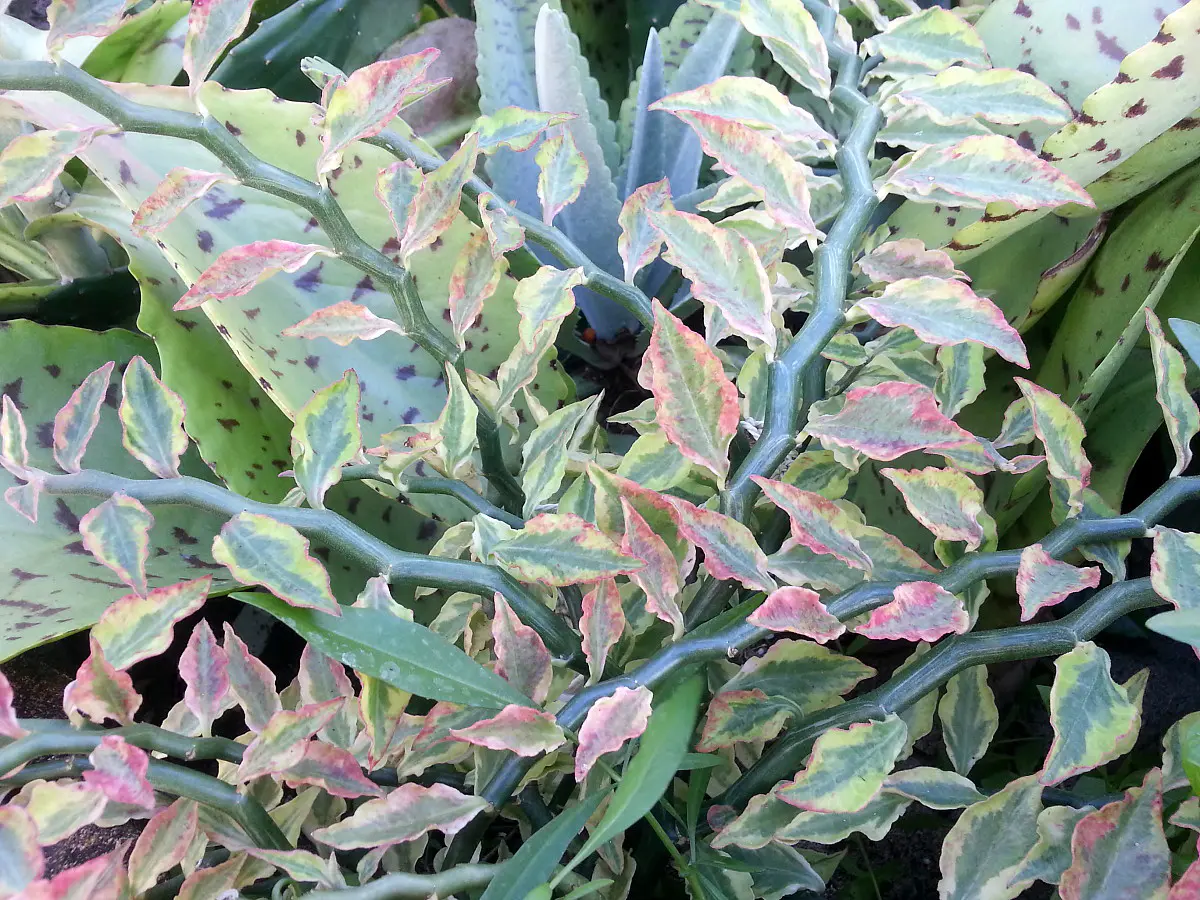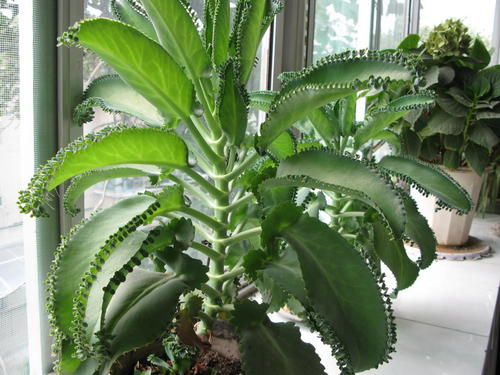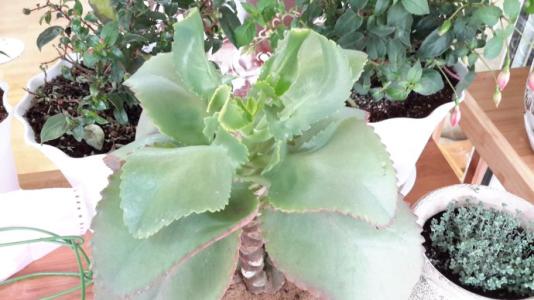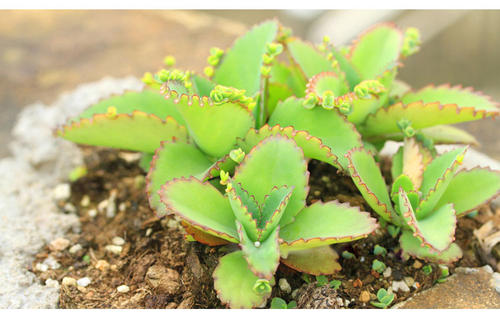Devils Backbone (Euphorbia Tithymaloides) Profile - Grow and Care for
Written by Maggie
Nov 12 2021

Devil's Backbone, scientific name Euphorbia Tithymaloides, leaves are thick and juicy, and its edges grow neat and beautiful adventitious buds. Devil's Backbone looks like a group of small butterflies, which fly to the ground and take root immediately to breed their offspring. It is quite interesting. Devil's Backbone likes warm and humid and sunny environments, not cold, drought resistance. It is advisable to loose and well-drained acid soil. The temperature in winter is not lower than 8℃.
Devil's Backbone picture

Devils Backbone Quick Info
| Botanical/Scientific Name | Euphorbia Tithymaloides |
| Common Name | Devil's Backbone |
| When to Grow/Bloom/Harvest | Plant in direct sun in fall and winter |
| Uses | Inflammatory and infectious diseases, diarrheal episodes, fever, cough, and wound healing |
| Origin | Roseland, Virginia, US |
| Light Care | Bright indirect sunlight |
| Soil Care | Moderately moist |
| Temperature Care | Below 40° degrees Fahrenheit during the winter |
| Humidity Care | Moderately moist, yet not soggy |
| Watering | Water when the top few inches of soil feels dry |
| Pruning Care | Trim back lightly in late winter |
| Fertilizer Care | Liquid fertilizer |
| Propagation | From cuttings |
| Toxic | Toxic |
| Flower Color | White, pink, red |
Characteristics of devil's backbone
The Devil's Backbone (Euphorbia Tithymaloides) is a perennial fleshy herb, 40-150 cm high;Stem branched.Pinnate compound leaves, 10-30 cm long, leaflets oblong to elliptic, 6-8 cm long, 3-5 cm wide, apex blunt, edge with round teeth, the bottom of the round teeth easy to bud, bud is grown into a new plant on the ground; Petiole of Devil's Backbone is 2-4 cm long.Panicles terminal, 10-40 cm long; Flowers are pendulous, calyx cylindrical, 2-4 cm long;Corolla tall discate, 5 cm long, base slightly enlarged, upward tubular, lobes 4, ovate-lanceolate, stamens 8 of pale red or purplish red, with corolla base, filaments long scales sub oblong carpels 4.
Devil's backbone growth habit
Devil's Backbone likes light and water, especially in the summer to reduce the number of watering to prevent root rot.
Devil's Backbone likes full sunshine, warm and humid environment, more tolerant, very cold resistance, suitable for growing in well drained acid soil. The Devil's Backbone is resistant to drought. prefer fertile sandy loam with good drainage. The optimum temperature for growth is 13 ~ 19℃, and the temperature in winter is 7 ~ 10℃.
Devils Backbone Care in Detail
Devils Backbone Watering
We should control the watering amount during the growth of devils backbone. Generally, we should water it after the soil is dry.
Devils Backbone Soil
For the cultivation soil of devils backbone, we should choose sandy loam with good drainage and ventilation. We can turn the pot once a year or every other year. When the branches are too long, we should cut them short or set up pillars to support them. With few branches, trim the branches as appropriate to promote more lateral branches.
Devils Backbone Light
Devils backbone can withstand shade. If it is cultured in semi shade, it will be conducive to flowering. During breeding, it is necessary to avoid strong sunlight exposure, especially in summer.
Devils backbone does not have strict requirements for light. The leaf color is red under strong light and green under half shade. However, we should not let the devils backbone be directly exposed to strong sunlight in summer, and do not put it in too dark places indoors.
Devils Backbone Temperature
Devils bBackbone likes to be warm. It is suitable for growth at ordinary room temperature in spring, summer and autumn. In winter, when the temperature is lower than about 13 ℃, the leaves can turn white and fall off.
Devils backbone is warm and drought-resistant, and the suitable temperature for growth is 23 ℃ - 30 ℃. After being frozen, the leaves will turn white and fall off. It is shade tolerant, the cultivation site is half shade, which is conducive to flowering, and the leaf color is beautiful. Devils backbone is wind resistant and suitable for growing in dry and windless environment.
Devils Backbone Humidity
We must keep the relative humidity of the air at 75 ~ 85 {BF} to plant devils backbone. We can also reduce the moisture evaporation of cuttings by spraying.
Devils Backbone Fertilizer
We can apply fertilizer to devils backbone with organic fertilizer or a small amount of nitrogen, phosphorus and potassium fertilizer. Reduce the supply of fertilizer and water in winter.
Devils Backbone Pruning
It's important to prune devils backbone in time. When we breed devils backbone, we need to prune it in time. We can observe its growth state. When the branches are too long, we should cut them off in time and cut off the upper end of the branches, which can promote devils backbone to plant multiple branches.
Devils Backbone Repotting
The devils backbone needs to be treated with flowerpots every 1-2 years. What are the specific methods for changing the pots of devils backbone? According to the plant type, the size of the root system can be selected for planting, and small stones can be placed at the bottom of the tile to achieve the effect of filtration, and then planting can be carried out.
Devils backbone has strong adaptability to soil. During planting, the soil dominated by air permeability can be selected, which can be prepared with 3 parts of vegetable garden soil and 1 part of rotten slag, or garden soil and river sand in the proportion of 4:1. The soil has strong air permeability and is suitable for the growth of Devils backbone.
When the devil's backbone is dug out to replace the pot, it is necessary to check whether there are rotten parts of the root system, repair and cut off the rotten parts with sterilized scissors, and properly trim the old roots that have grown for many years. Take an appropriate amount of potassium permanganate solution to soak the root system, and plant in the pot after soaking for 20 minutes.
When changing pots, devils backbone should have some original soil, which can increase the adaptability of plants. We can put devils backbone plants into flower pots and gradually add nutrient soil. Then we can gently tap the soil with our hands to make the roots closely connected with the soil, water and soak them, and place them in a cool environment for maintenance.
Devil's backbone propagation methods
Devil's Backbone commonly used cutting propagation, adventitious bud and sowing propagation. Cuttage, with late spring to summer best, will be a robust leaf flat on the sand bed, with sand close, maintaining humidity. One week after insertion, plantlets could grow out from the tines of the leaf margin.When fully grown, cut and transfer to the basin. Cut the top branches of Devil's Backbone to 8-10 cm long. Insert them into a sand bed after a little dry. Root in 1 week. Propagation of Devil's Backbone is more convenient. The larger adventitious buds growing on the leaf edge can be directly put into the pot. Sowing, small seeds, not covered with soil after sowing, about 12-15 days after germination, germination rate is high.

Devils Backbone Propagation from Cutting
Devils backbone can be propagated by cutting. Cutting can be used in greenhouse all year round, but it is better to cut in warm season. Take the shoot or tender stem and cut it into 10 cm long stem segments as cuttings. We should dry the cuttings of devils backbone first, or insert the incision into dry ash and dry soil to make the slurry absorbed, and then cut. The media of devil backbone propagation from cutting can be yellow sand, perlite or rice husk ash. After the cuttings take root, they can be transplanted into the pot.
Devils Backbone Propagation from Layering
For the devil backbone propagation from layering, we can select healthy and strong branches from the mature devil backbone, peel off a circle of bark about 15 ~ 30 cm below the top tip, the wound width is about 1 cm, and the depth is limited to just peeling off the skin. Then use scissors to cut a piece of film with a length of 10 ~ 20 cm and a width of 5 ~ 8 cm. Put some wet soil on it. Wrap up the stripped bark with film, tie it into the upper and lower ends of the film, and drum up in the middle. Take root after about 4 to 6 weeks. After the devils backbone takes root, we need to cut off the roots next to the branches, so that a new plant will grow.
Devil's backbone growing methods
Potted available rot leaf soil and coarse sand each half of the mixed soil. When growing Devil's Backbone, water a little more, keep the pot soil moist, but not water. When the temperature drops in autumn and winter, watering should be reduced. Winter flowering, strictly controlled watering, but don't forget to water. Fertilizer Devil's Backbone once a month during the growing period. When the stem and leaf grow too high, should pick the heart to depress the plant shape, promote its more branches. Every spring to renew the pot, maintain a beautiful plant state of Devil's Backbone.
Devil's backbone plant diseases and insect pests
There are mainly gray mold, powdery mildew harm, available 70% methyl tobutien wettable powder 1000 times the liquid spray. Insect pest of Devil's Backbone has scale insect and aphid harm, with 40% diego emulsion 1000 times liquid spray kill.
Devil's backbone application
Devil's Backbone is the most common kind of succulent plant.Its leaves are thick and juicy, and its edges grow neat and beautiful adventitious buds. Devil's Backbone looks like a group of small butterflies, which fly to the ground and immediately take root to breed their offspring. It is quite interesting. Be used to potting, it is the good material of the afforestation of windowsill afforestation, adornment study and guest room also provide refined taste.

Devils Backbone Benefits
Devils backbone is often used as a medicinal material. Although it tastes slightly bitter and has certain toxicity, cardinal coral can treat many diseases of our human body as long as we pay attention to the principle of moderation. It can clear away heat and toxin, remove blood stasis and inflammation, stop bleeding and cool blood. Devils backbone can not only be taken orally, but also applied externally. Its external value is that it can treat traumatic injuries, fractures, traumatic bleeding, ulcers, etc. it only needs to be applied to the affected area.
As a flower, coupled with its unique shape, devils backbone can always attract a group of favorite audiences. Devils backbone lacks the charming characteristics of small flowers, but has more domineering and natural flavor. For lovers, devils backbone is a free and robust flower, so for us, devils backbone has a special appreciation value.
Latest Updated
- Benefits of Bugleweed - 7 Science-backed Health Benefits
- Bugleweed Dangers & Side Effects - Is It Poisonous?
- How to Plant Evergreen Trees - What You Should Know
- When to Plant Evergreens - Grow Guide for Evergreen Trees
- 12 Wonderful Evergreen Shrubs for Your Garden
- 12 Popular Evergreen Plants with Pictures for Beginners
- When And How To Prune A Lilac Bush Like a Pro
- How to Grow & Care for Lilac Vine (Hardenbergia Violacea)
- Japanese Lilac Tree (Syringa Reticulata) Care & Propagation Guide
- Shumard Oak Pros and Cons - What to Know
Popular Articles
- Winter maintenance of Antirrhinum Majus
- How to Grow Terminalia Mantaly Tree
- How to Grow and Care for Crossostephium Chinense
- How to grow Antirrhinum Majus in spring
- Peristeria Elata (Dove Orchid) Profile: Info & Care Guide
- Underwatered Snake Plant (Sansevieria Trifasciata) - Signs And How To Fix
- How to Care for Brazilian Jasmine Plant (Mandevilla Sanderi)
- How to Grow & Care for Graptopetalum Purple Delight in Summer
- Rosa Chinensis (China Rose): Plant Growing & Care Tips
- How to Care for Baby Sun Rose (Aptenia Cordifolia)